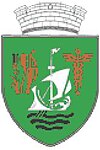Mangalia
| Mangalia | ||
|---|---|---|
| Municipality | ||
 |
||
|
||
| Location of Mangalia | ||
| Coordinates: 43°49′02″N 28°34′58″E / 43.81722°N 28.58278°ECoordinates: 43°49′02″N 28°34′58″E / 43.81722°N 28.58278°E | ||
| Country |
|
|
| County | Constanța County | |
| Status | Municipality | |
| Government | ||
| • Mayor | Cristian Radu (National Liberal Party) | |
| Area | ||
| • Total | 62.26 km2 (24.04 sq mi) | |
| Elevation | 20 m (70 ft) | |
| Population (2011) | ||
| • Total |
|
|
| Time zone | EET (UTC+2) | |
| • Summer (DST) | EEST (UTC+3) | |
| Climate | Cfa | |
| Website | http://www.mangalia.ro/ | |
Mangalia (Romanian pronunciation: [maŋˈɡalia], Turkish: Mankalya, ancient Callatis (Greek: Κάλλατις/Καλλατίς), other historical names: Pangalia, Panglicara, Tomisovara), is a city and a port on the coast of the Black Sea in the south-east of Constanța County, Romania.
The municipality of Mangalia also administers several summer time seaside resorts: Cap Aurora, Jupiter, Neptun, Olimp, Saturn, Venus.
The Greek town Callatis existed until mid 7th century under this name. Life in the town resumed from 10th century. In the 13th century Callatis came to be known as Pangalia The Vlachs called it Tomisovara and the Greeks - Panglicara. From 16th c. the town had acquired its present name Mangalia. A Greek colony named Callatis was founded in the 6th century BC by the city of Heraclea Pontica. Its first silver coinage was minted approximately 350 BC. In 72 BC, Callatis was conquered by the Roman general Lucullus and was assigned to the Roman province of Moesia Inferior. Throughout the 2nd century AD, the city built defensive fortifications and the minting of coinage under the Roman emperors Septimius Severus and Caracalla continued. Callatis suffered multiple invasions in the 3rd century AD but recovered in the 4th century AD to regain its status as an important trade hub and port city. From 7th to 11th century the city was under the rule of the First Bulgarian Empire.
...
Wikipedia


